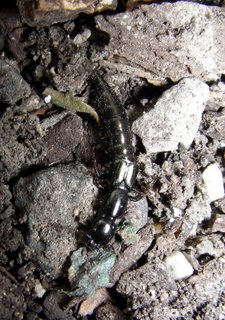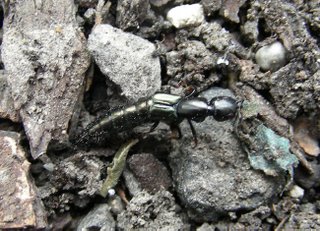Wherefore the Darragh Daol should be killed whensoever met. But there is only one safe way of doing it, they say in Co. Wicklow, for if you kill it with your thumb, as is done in the south of Ireland, or crush it with your boot, a stone, or a stick, the slightest blow from the thing used for its destruction occasions a mortal injury to either men or animals.
 But this is another species of staphylinid. I'm not sure which one as there are about 50,000 species worldwide, of which at least 1,000 occur in Australia. Unlike the Oxychilus snails mentioned in the previous post, they don't all look the same. But it still requires experts to tell them apart. The Austral Staphylinidae team would have a much better idea about it than I would.
But this is another species of staphylinid. I'm not sure which one as there are about 50,000 species worldwide, of which at least 1,000 occur in Australia. Unlike the Oxychilus snails mentioned in the previous post, they don't all look the same. But it still requires experts to tell them apart. The Austral Staphylinidae team would have a much better idea about it than I would.Many staphylinids are predators but others feed on decaying matter, including corpses. (I found this one heading out from under my house, which worries me a bit.)
 They have most of the features present in other beetles but look different because the hard wing cases (elytra) are reduced, so do not cover the abdomen. This makes them look a little like earwigs, although the two are not closely related. (They belong to different orders.) Despite the reduction in the elytra, the wings themselves are usually fully functional and many species are good fliers.
They have most of the features present in other beetles but look different because the hard wing cases (elytra) are reduced, so do not cover the abdomen. This makes them look a little like earwigs, although the two are not closely related. (They belong to different orders.) Despite the reduction in the elytra, the wings themselves are usually fully functional and many species are good fliers.I'm always amazed at the diversity of even the smallest, most appallingly-maintained city gardens.
Reference
Leather, E.M. (1916) Notes on Irish folklore: insects. Folklore 27 (4): 419 – 420.